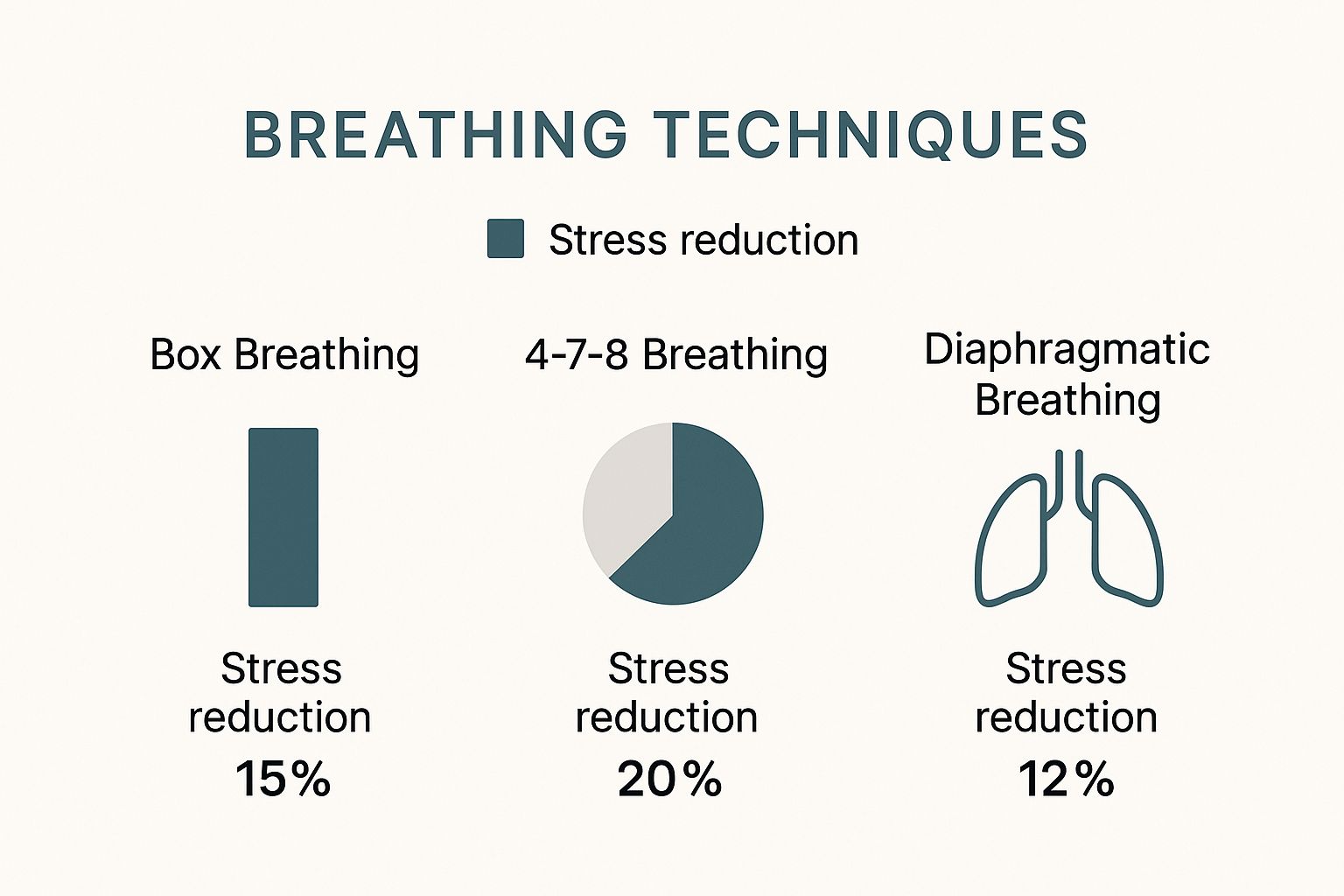
Your Practical Guide to a Stress Management Class
Share
Feeling overwhelmed is a signal, not a weakness. For busy professionals like educators, entrepreneurs, and creators, the pressure can feel relentless. That's where a stress management class comes in—it’s not another item on your to-do list, but a practical toolkit designed to give you back control, time, and mental clarity. Think of it less as a lecture and more as a hands-on workshop for your mind, helping you spot stress triggers and build effective, time-saving strategies to handle them.
A Practical Toolkit for Your Mind

Let’s reframe what a stress management class is. It’s not about eliminating stress—that’s impossible and not even healthy. Instead, it’s about fundamentally changing your relationship with pressure. The goal is to learn how to transform that feeling of being swamped into a challenge you can confidently navigate, saving your energy for what truly matters.
Built on proven psychological insights, these classes offer a supportive space to recognize the early warning signs of stress before they spiral. Getting ahead of that curve is the key, especially when you're juggling so many responsibilities. This proactive approach helps you reclaim your focus and increase your productivity without burning out.
Who Really Benefits From These Classes?
While anyone can benefit, these skills are a game-changer for professionals in demanding roles. A stress management class helps you shift from a reactive mode—constantly putting out fires—to a proactive one where you feel in control of your day and your energy.
Here’s how it offers practical takeaways for specific groups:
- For K-12 Educators: You'll gain concrete strategies for managing classroom demands, administrative tasks, and the emotional toll that leads to burnout. The result is more energy and patience for your students and more time for innovative teaching.
- For Small Business Owners: You’ll learn techniques to maintain a clear head for sound decision-making, even when facing market uncertainty or tight deadlines. It’s about preventing pressure from clouding your judgment and hijacking your productivity.
- For Content Creators: This class provides tools to handle the constant demand for new ideas, overcome creative blocks, and manage feedback without letting the pressure stifle your inspiration.
Ultimately, a stress management class helps you build a personalized toolkit. It’s not a one-size-fits-all solution, but a supportive journey to discover what truly works for your mind and your unique professional challenges.
Building Resilience and Reclaiming Your Focus
The true value of a stress management class lies in building long-term resilience. Once you understand your personal stress triggers, you can develop targeted strategies to cope. For example, you might learn a simple breathing exercise to quickly calm your nervous system before a big presentation or a time-saving technique to prevent tasks from piling up.
This isn't about adding more to your plate. It's about working smarter—not harder—to protect your mental energy. The payoff is a renewed sense of focus, increased productivity, and the ability to navigate life’s inevitable pressures with more confidence and ease.
The Real-World Benefits of Managing Stress
Learning to manage stress is a direct investment in your professional life. It gives you back mental energy, sharpens your focus, and can even save you precious time. These aren't vague concepts—the benefits are practical and show up in your day-to-day work, transforming how you solve problems and get things done.
Ultimately, this is about quieting the mental noise so you can perform at your best. For any busy professional, the positive impact is almost immediate.
A Practical Boost to Your Productivity
Think about the last time you felt completely overwhelmed. Your focus was likely scattered, and even small tasks felt monumental. A good stress management class gives you the tools to stop that mental fatigue before it takes over. It helps you find a more sustainable work rhythm, so you can achieve more without that constant feeling of frantic effort.
- For Educators: Imagine having the mental space to craft truly engaging lessons and more patience for your students, even during the busiest weeks of the school year. That's what happens when your energy isn't constantly drained by stress.
- For Small Business Owners: Picture leading your team with a clear, confident vision instead of a knot of anxiety. When you manage stress effectively, you make smarter, more strategic decisions, unclouded by pressure.
- For Content Creators: This is your key to breaking through creative blocks and consistently producing your best work. It’s about protecting your creative spark from the burnout that so often accompanies a creative career.
The Bigger Picture in the Workplace
The need for these skills has never been clearer. The economic impact of work-related stress is significant, highlighting just how vital these coping strategies are. Depression and anxiety cost the global economy an estimated $1 trillion each year, leading to 12 billion lost workdays. With over 80% of U.S. workers reporting job-related stress, it's a universal challenge. To understand the full scope, you can explore the latest workplace burnout statistics from TherapyRoute.
By learning to manage your own stress, you're not just helping yourself. You’re fostering a healthier, more productive, and more supportive work environment for everyone around you.
This is precisely why so many companies are incorporating employee wellness program ideas into their core strategy. Investing in these skills is a smart move that pays dividends in both well-being and performance. It’s about creating a culture where people can thrive, not just survive.
Exploring Different Types of Classes
Choosing a stress management class isn't a one-size-fits-all decision. The best program for you will align with your schedule, learning style, and specific goals. From interactive workshops that foster community to flexible online courses you can take at your own pace, there’s a format out there that will feel like a perfect fit for your busy life.
The key is to understand what makes each option unique. By considering the delivery method and core philosophy, you can confidently choose a program that provides the right tools in a way that works for you.
Finding the Right Learning Environment
One of the first decisions is figuring out how you want to learn. Do you thrive on group energy and interaction, or do you prefer to learn and reflect on your own? Your answer will guide you toward the right class structure.
Here are the most common formats you'll encounter:
- In-Person Workshops: These are great if you value face-to-face connection and community support. They offer dedicated time away from daily distractions, allowing you to fully immerse yourself in the material.
- Live Online Classes: A fantastic middle ground, these provide the structure and real-time feedback of a live instructor with the convenience of learning from anywhere. This is ideal for a busy professional who wants direct connection without the commute.
- Self-Paced Online Courses: For anyone with an unpredictable schedule—like small business owners or content creators—these offer maximum flexibility. You can engage with the material whenever you have a moment, without the pressure of a fixed timetable.
To help you decide, let's look at how these formats compare.
Comparing Stress Management Class Formats
This table breaks down the most common formats to help you choose the best fit for your schedule and learning style.
| Format Type | Best For | Key Advantages | Potential Drawbacks |
|---|---|---|---|
| In-Person Workshops | People who learn best through interaction and enjoy building a sense of community. | Direct access to the instructor, hands-on practice, and a strong support network. | Less flexible scheduling, requires travel, and can be more expensive. |
| Live Online Classes | Those who want the structure of a live class but need the convenience of remote learning. | Real-time Q&A, accountability from scheduled sessions, and accessible from anywhere. | Tied to a specific time zone; potential for technical glitches. |
| Self-Paced Courses | Individuals with busy or unpredictable schedules who need maximum flexibility. | Learn at your own pace, access materials anytime, and often more affordable. | Requires self-discipline; no live instructor feedback or group interaction. |
Ultimately, the best format is the one you’ll actually complete. Be realistic about your lifestyle before you commit.
Understanding the Methodologies
Beyond format, classes are built around different psychological philosophies. Each offers a unique and effective lens for understanding and managing stress. Think of them as different operating systems for your mind—all are powerful, but each has a different interface.
The most powerful stress management techniques are often the simplest. It’s not about finding a complex solution, but about consistently practicing fundamental skills that calm the nervous system and reframe your perspective.
Many classes rightly focus on practical exercises like breathing techniques because they deliver immediate results. This infographic shows just how quickly three popular methods can lower stress.

As the data shows, even a simple, controlled breathing exercise can have a measurable impact. The 4-7-8 method, for instance, showed a 20% reduction in stress. This is a perfect example of how a good class equips you with quick, actionable tools you can use anytime, anywhere.
Some of the most respected methodologies you’ll encounter include:
- Mindfulness-Based Stress Reduction (MBSR): This approach trains you to pay attention to the present moment without judgment. It’s incredibly effective for breaking the cycle of worrying about the future or ruminating on the past—a major source of stress for entrepreneurs and creators.
- Cognitive Behavioral Therapy (CBT) Techniques: CBT is about identifying and shifting the negative thought patterns that fuel stress. An educator overwhelmed by a new curriculum might learn to reframe the thought "This is impossible" into "This is a challenge, and I can tackle it one step at a time."
- Somatic Approaches: These methods focus on the mind-body connection—how stress manifests physically. By learning to release stored tension through gentle movement or body awareness, you address stress at its physiological root.
What You Will Learn in a Typical Class

So, what actually happens in a stress management class? It’s not just talking about stress; it’s about giving you a practical, hands-on toolkit you can start using right away to save time and reduce overwhelm.
These courses are designed to break down the feeling of "being stressed" into manageable components. The goal is to move you from simply understanding stress to knowing exactly what to do about it in the moment.
Identifying Your Personal Stress Triggers
You can't solve a problem if you don't know its cause. That's why the first step in any effective class is self-awareness—learning to pinpoint your unique stress triggers. For a teacher, it might be the transition after recess. For an entrepreneur, it could be opening financial reports. This module is about recognizing those patterns so you can address them proactively.
Practical Mindfulness and Breathing Exercises
Once you know your triggers, the next step is learning how to calm your body and mind on demand. This is where you learn practical mindfulness and breathing exercises. These are scientifically-backed methods for regaining control when your nervous system feels hijacked. You'll learn simple yet powerful techniques, like box breathing or the 4-7-8 method, that you can use in minutes before a high-stakes meeting or a challenging classroom moment.
The core idea is simple: You learn to anchor yourself in the present, preventing your mind from spiraling into worst-case scenarios about the future or regrets about the past.
These foundational skills are crucial for staying composed under pressure. You can discover more workplace stress management techniques that build on this very principle.
Time Management for a Calmer Mind
For many of us, stress stems from one feeling: too much to do, not enough time. This part of the class connects how you manage your schedule to how you manage your stress. It’s about reclaiming control over your day to increase your productivity.
You'll explore proven, time-saving strategies like:
- The Pomodoro Technique: This method uses focused 25-minute work intervals to help you tackle large projects without feeling overwhelmed, making it a game-changer for content creation or lesson planning.
- Task Prioritization: Using tools like the Eisenhower Matrix, you'll learn to distinguish what's truly important from what's merely urgent. This helps you invest your best energy where it will make the biggest impact.
Building Resilient Thinking Patterns
Finally, a truly comprehensive class helps you rewire the very thought patterns that create stress, often using principles from Cognitive Behavioral Therapy (CBT). You'll learn to spot automatic negative thoughts—like "I'm going to fail this presentation"—and consciously challenge them. You can reframe it to something more realistic and supportive, like, "This is tough, but I am prepared and can handle it." This mental shift builds long-term resilience, making you a more confident and effective professional.
How to Choose the Right Class for You

Finding the right stress management class is about taking an honest look at your needs and finding a program that aligns with your life. Before you start looking, ask yourself: what is my goal? Are you a teacher aiming to prevent burnout? Or a small business owner who needs to stay level-headed during a crunch period? Clarifying your objective is the first step to finding a class that will genuinely help.
Your Actionable Checklist for Vetting Programs
To simplify your search, use this checklist to cut through the noise and find a program that’s worth your time and investment.
- Check the Instructor's Background: Look at their credentials. Do they have a solid background in psychology, coaching, or a related field? Real-world experience with professionals in your industry is a major asset.
- Understand the Methodology: Is the class based on proven techniques like Mindfulness-Based Stress Reduction (MBSR) or Cognitive Behavioral Therapy (CBT)? A quality program will be transparent about its methods.
- Read Reviews and Testimonials: What do past participants say? Reviews offer the best insight into the teaching style and whether the class delivered on its promises.
- Assess the Fit: Be realistic about the time commitment and cost. View it as an investment in your well-being, but ensure it works with your current schedule and budget.
Investing in your team's mental health is one of the smartest business decisions you can make. A well-chosen stress management class pays dividends in improved focus, lower absenteeism, and a more positive work culture.
A Smart Investment in Your Business
For small business owners, this is more than a personal expense—it's a strategic investment. The workplace stress management market has grown to an $11.3 billion valuation, a clear sign that companies recognize employee well-being as critical to the bottom line. You can learn more about the growth of the workplace stress management market.
As you evaluate programs for yourself or your team, consider the long-term return. Less stress leads directly to better decision-making and increased efficiency. For educators, these skills are among the most effective teacher time management strategies you can adopt. When you choose the right class, you're building a foundation for a more resilient and productive future.
Common Questions About Stress Management
Deciding to take a stress management class is a great first step, but it's normal to have a few questions. Making a commitment can feel daunting, especially when you're already feeling stretched thin.
Let's walk through some of the most common concerns. Getting clarity on these points can help you move from feeling stuck to taking supportive, meaningful action.
Will This Really Work for My Schedule?
This is the most practical question of all. As an educator, entrepreneur, or creator, you don't need another obligation. The fear is that the class itself will become another source of stress.
A well-designed class is built to give you back time, not take more of it. By teaching you how to focus, prioritize, and manage your energy, the hours you invest upfront will pay dividends in future productivity. The key is finding a format that fits your life. A rigid in-person workshop might be out, but a flexible, self-paced online course could be a perfect fit. Think of it as organizing a cluttered space—it takes effort initially, but the long-term result is a smoother, easier daily routine.
Are the Results from a Stress Management Class Long-Lasting?
It’s natural to be skeptical. Will the calm, focused feeling from a class last, or will it disappear at the next deadline?
The answer depends on the class's approach. A truly effective program doesn't offer a temporary fix; it helps you build resilient thinking patterns. You learn to fundamentally change your relationship with stress by rewiring automatic, knee-jerk reactions.
A great stress management class is less like taking a painkiller and more like learning proper posture to prevent the headache in the first place. The skills become a permanent part of your mental toolkit.
Instead of just treating symptoms, you learn to address the root cause. This shift—from reacting to stress to proactively building resilience—is what creates real, lasting change, equipping you to handle challenges long after the class ends.
How Quickly Can I Apply What I Learn?
You should be able to apply new skills almost immediately. The best classes are designed for real-world application, so you don't have to wait weeks to feel the benefits. From the very first session, you should walk away with a practical technique you can use that day—like a two-minute breathing exercise to ground yourself before a parent-teacher conference or a task-batching method to clear your inbox faster. These quick wins build confidence and momentum, helping the bigger concepts stick.
Is This Just for People Who Are Already Burned Out?
Absolutely not. In fact, a stress management class is most powerful when used as a preventive tool. Waiting until you're completely exhausted is like waiting for your car to break down before getting an oil change. It's far smarter and more effective to build your resilience before you reach a crisis point.
This shift toward prevention is a growing trend. The global workplace stress management market was recently valued at around $7.35 billion, and is projected to grow to $9.47 billion by 2030, showing how much organizations are proactively investing in these skills. You can explore the data by checking out global workplace stress management market trends. For professionals in demanding fields, learning these skills early is a strategic career move that builds a sustainable foundation for long-term success.
At fenjaeducation.net, we create practical digital resources to help educators, creators, and small business owners save time, reduce stress, and increase productivity. Explore our collection of guidebooks, workbooks, and mini-courses designed to give you the tools you need to thrive. Discover a calmer, more focused way to work at https://fenjaeducation.net.